SAFETY, HEALTH AND ENVIRONMENT
SAFETY, OCCUPATIONAL HEALTH AND ENVIRONMENT (SHE)
Thai Union is one of the world’s leading seafood processors. We work to protect our people, our communities, marine resources and our planet by addressing global environmental risks such as climate change, resource consumption and waste management.
For many years, Thai Union has developed and implemented many initiatives that align with the UN Sustainability Goals including SDG 8 - Decent Work and Economic Growth, SDG 12 – Responsible Consumption and Production, and SDG 13 - Climate Action. In July 2023, Thai Union announced SeaChange® 2030, an expansion of its sustainability strategy introduced in 2016. Under SeaChange® 2030, Safety, Occupational Health, and Environment will be addressed through three key commitments: ‘Path to Net Zero Emissions’, ‘Best-In-Class Manufacturing,’ and ‘Safe, Decent, and Equitable Work’.
We have initiatives in place that contribute to water reduction, energy efficiency, waste-to-landfill reduction, reducing greenhouse gas emissions and accident reduction in our workplace. We want everyone who works for Thai Union to play an active role in delivering our safety, health and environmental goals—we see safety and environmental protection as everyone’s business. We also strive to make advances in our occupational health and safety policies, continually strengthening our safety standards, procedures and processes. For more information on Thai Union’s environmental performance, please see here.
As a responsible business, Safety, Occupational Health, and Environment are key pillars that have important roles and responsibilities in contributing to sustainable harmonization. Part of this responsibility is to communicate about the Company's environmental management policy and our environmental impacts both internally and externally, between our operations, our employees, ecosystems, and society.
SAFETY, HEALTH AND ENVIRONMENT POLICY
Culture: we will systematically integrate SHE considerations into every business decision to make a real positive improvement towards a safe workplace, the community and the environment. This includes empowering our employees and stakeholders to recognize the SHE impacts of their work activities and the impact of the Company’s mitigation initiatives via effective competency training, communication, and assurance.
Compliance: we will be fully accountable for compliance with applicable SHE legislations, customer requirements, and appropriate international standards and guidelines.
Captivation of perspectives and consultation with stakeholders: we shall capture the viewpoints and experience of our employees, contractors, customers, suppliers, communities, and other stakeholders, as we believe the best SHE strategy, priorities and practices incorporate a broad range of perspectives.
Continual Improvement: Our measurable SHE targets shall always reflect our ambition to be the seafood industry’s leading agent of change. We shall continually monitor and review our SHE performance against the targets set as well as benchmark ourselves with stakeholders’ expectations and industry best practices for continual SHE performance improvement.
This policy applies to all Thai Union operations, including our subsidiaries. All employees, particularly management, shall demonstrate leadership and be accountable for policy alignment. All employees and contractors under Thai Union’s supervision are obligated to understand and ensure compliance with this policy throughout all work activities.
SAFETY, OCCUPATIONAL HEALTH, AND ENVIRONMENT (SHE) MANAGEMENT FRAMEWORK
Thai Union’s Safety, Health, and Environment (SHE) division works tirelessly to develop and implement stringent protocols to meet our commitments to ensure that employees and personnel working for, and on behalf of Thai Union, are aware of the Company’s SHE requirements and to reduce our adverse environmental impacts and provide a healthy and safe workplace for our employees, contractors and suppliers.
In order to support the implementation of the SHE Management Framework, there are a set of SHE Guidelines to provide guidance for the sites with step-by-step procedures sn addressing each specific SHE topic according to the risk, hazard and environmental impact.
The SHE Guidelines comprise four main components: Process and Equipment Integrity, Human Well-Being, Environmental Stewardship, and Product Stewardship. See the SHE framework here.
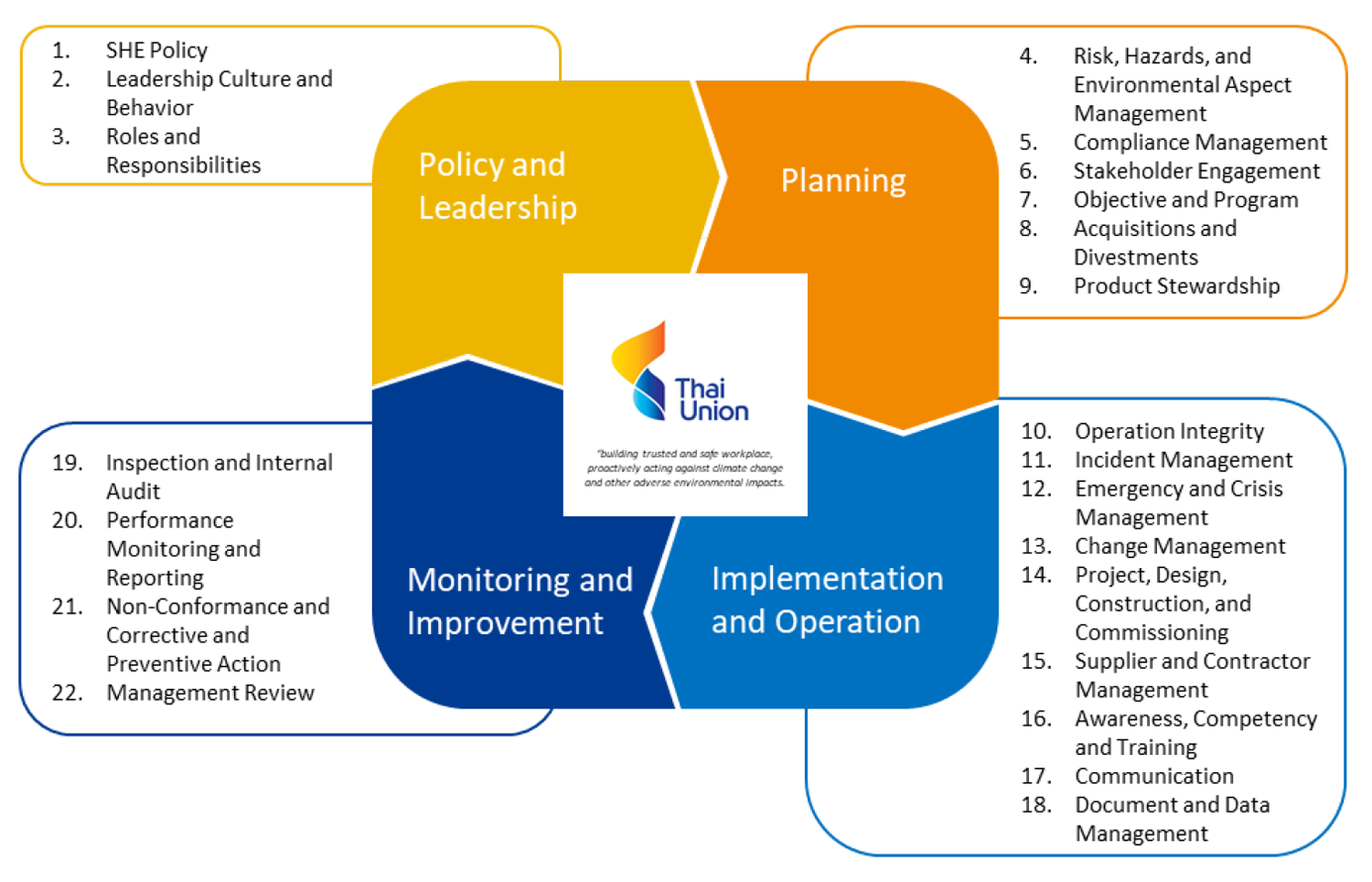
HEALTH AND SAFETY PROGRESS
COVID-19
In 2022, we continued to place our priority on the health, safety and well-being of our employees, partners, suppliers, and local community while ensuring our commitment to delivering safe products to our customers and consumers. Throughout 2022, we continuously monitored the situation and worked closely with local authorities, community leaders, and NGOs. This allowed us to adjust the measures to up-to-date risks to ensure the safety of our employees and communities.
SAFE IN WORKPLACE
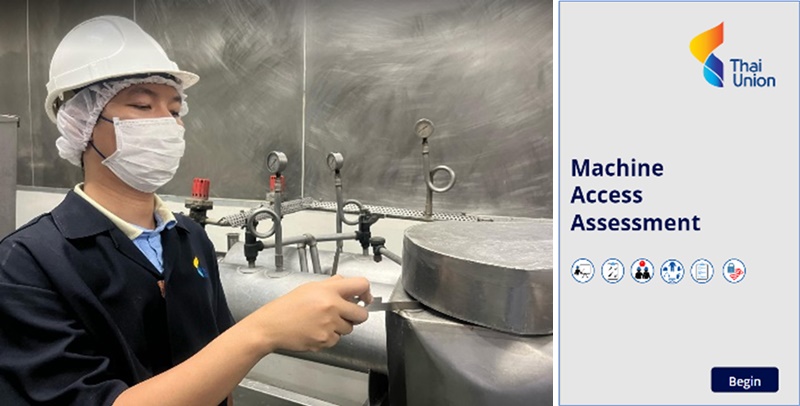
We have strengthened our operation controls as part of our safety culture building. This led to improvement in unsafe reporting, unsafe prevention, and recognition of safe behavior. As a result, we maintained our occupational illness frequency rate for employees at zero and we reduce our Lost Time Injury Frequency Rate-LTIFR2 by 18 per cent in 2022 compared to 2021.
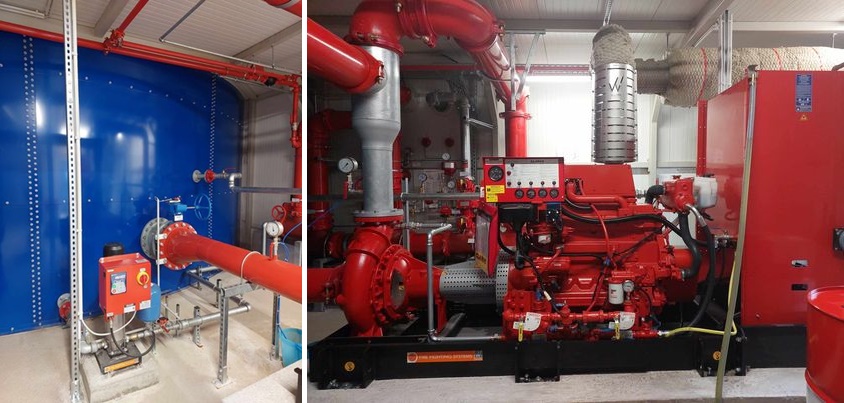
Despite the accident reduction trend, we recognized the concern in our machine safety practices. We have laid out a 2 year-program with the aim of achieving zero high-consequence injuries from machine related-accidents. The program elevates our practice to protect access to machine hazard points.
We continue to implement comprehensive fire risk improvements at our factories across the globe. This includes multiple million baht investment to improve our facilities as well as strengthen our risk administrative controls, e.g. electrical safety inspection which goes beyond regulatory compliance.
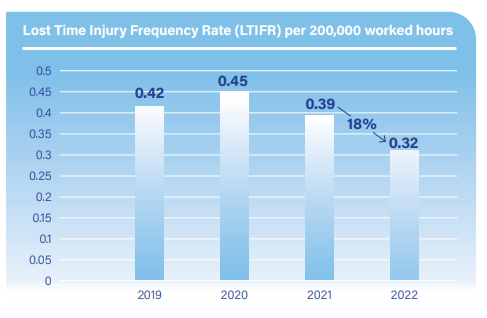
PATH TO NET ZERO
Climate change presents a "code red” threat to humanity. The world is currently on a trajectory that surpasses the critical climate target of limiting the temperature increase to 1.5°C above pre-industrial temperatures by 2030. To prevent devastating effects on our planet and its people, we must rapidly cut global greenhouse gas (GHG) emissions by half before 2030 — and achieve net zero by 2050
We are the first global seafood processor in the world to set 1.5°C aligned short-term and long-term goals verified by SBTi3, accelerating meaningful progress in our industry. Our purpose is to help regenerate ecosystems, heal the planet and support the people our business depends on.
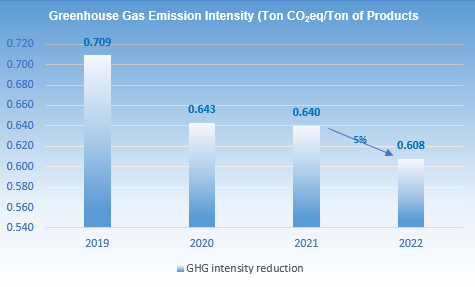
We have started implementing initiatives in our manufacturing sites to support our efforts to reduce greenhouse gas emissions. Our absolute greenhouse gas intensity (Scope 1 & 2) was reduced by 5 percent in 2022 compared to 2021. In 2022, we continued to implement low-carbon technology such as solar energy which contributes around 5 per cent of total electricity consumption, using biomass in our process, increasing the number of electric vehicles, and changing the freezing system from carbon dioxide to nitrogen. Thai Union also intends to neutralize residual emissions and/or further mitigate emissions beyond our value chain.
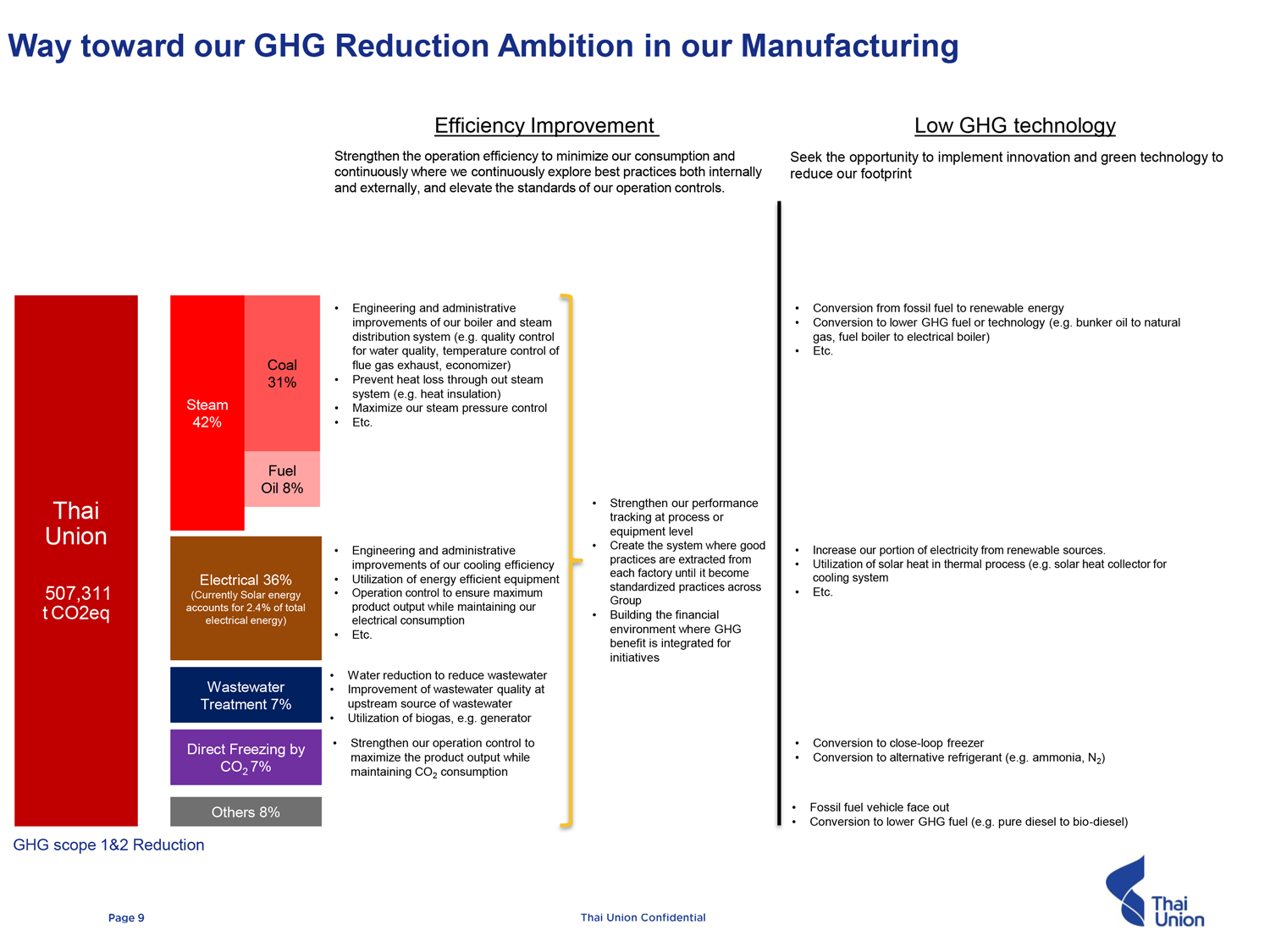
BEST IN CLASS MANUFACTURING
Create closed-loop factories by implementing zero water discharge, zero waste to landfill and zero food at our five largest processing facilities4.
WATER MANAGEMENT
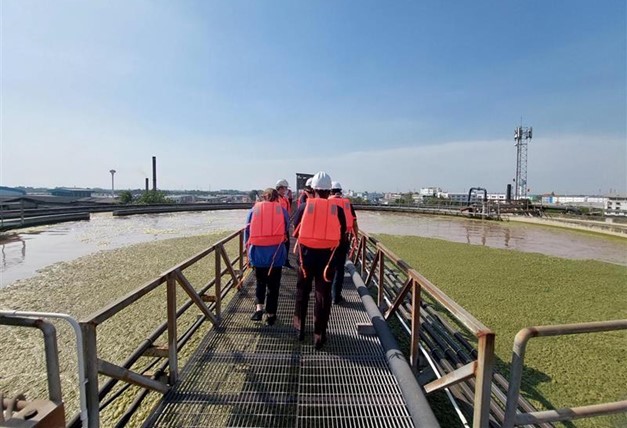
In recognition of increasing risk of water scarcity, our journey toward water consumption reduction continues. In 2022, we focused on our operation control and improvement of our water reuse/recycling under strict control of food safety standards. This includes water recycling for toilet flushing, water recycling for our cooling water, and water reuse for outdoor area cleaning.
Beyond the local requirements, we are aware of the types of pollutants that make up a more significant proportion of the wastewater system and follow the operating procedures to remediate water quality at acceptable levels, either to local public utilities (for further treatment), for reuse and recycling within their operations, or into the public environment.
In addition, we continue to work on strengthening our wastewater treatment operations. This includes our system to track wastewater treatment performance and improvement of our wastewater treatment plant. This helps to ensure we will be ready for our ambition of high-water reuse and recycling strategies in order to achieve zero water discharge.
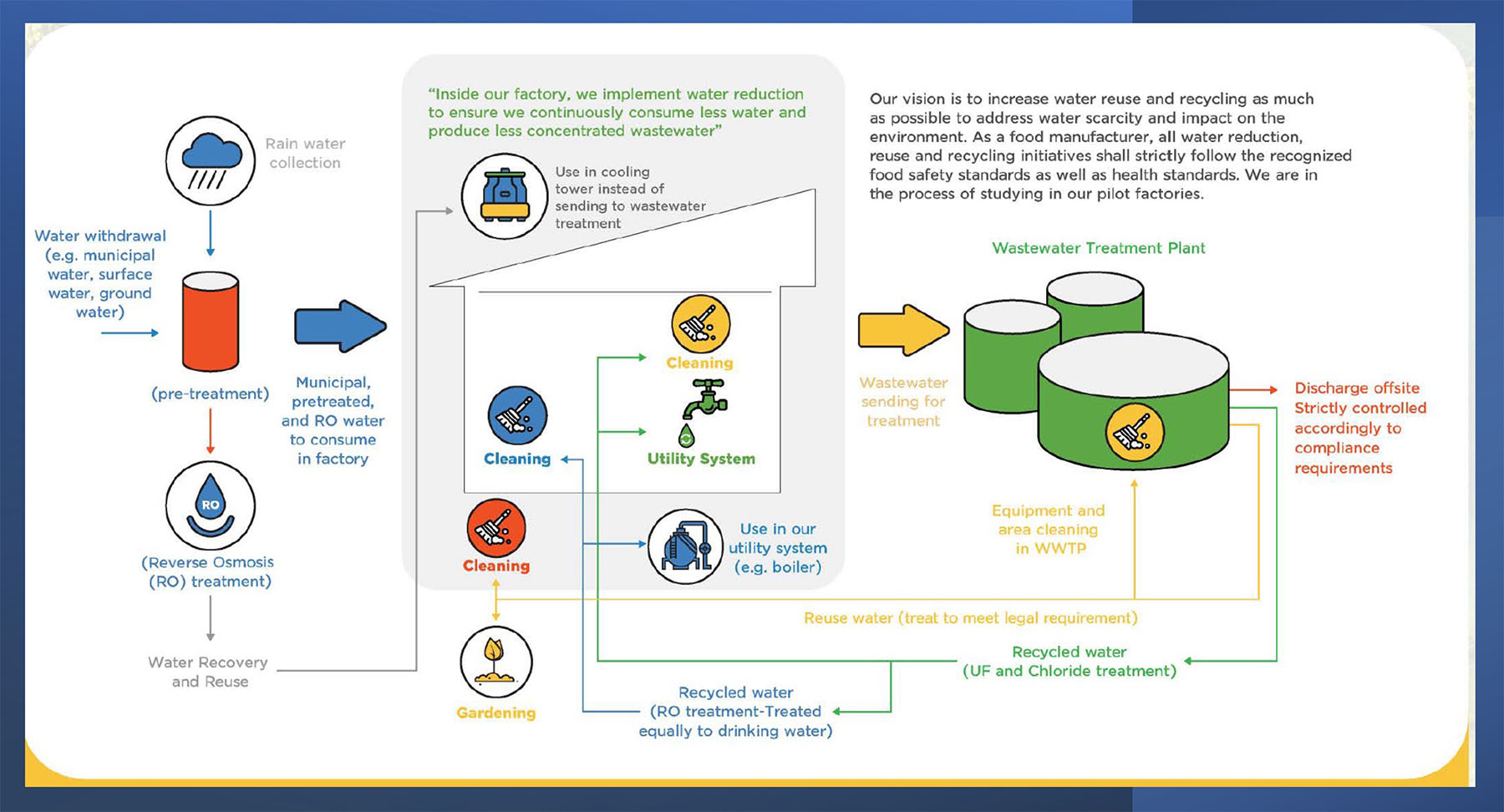
WATER STRESS RISK ASSESSMENT AND MANAGEMENT
In 2022, Thai Union assessed water-related risks by the Aqueduct Water Risk Atlas 3.0, developed by the World Resources Institute (WRI). The assessment includes Physical Risk Quantity (e.g. baseline water stress, Riverine Flood Risk, and Drought Risk), Physical Risk Quality, and Regulatory and Reputational Risk for our manufacturing facilities our critical tier 1 suppliers.
We found that 3 percent of our manufacturing facilities5 are located in water stress areas where water withdrawal accounts for 2 percent of our total water withdrawal. In addition to consumption efficiency improvement and pushing for higher reuse and recycled water, we have also explored water withdrawal sources in order to reduce the impacts on water stress in the area. In 2022, we collected water through rain harvesting internally and externally, and 1,592,370 m3 of seawater, or 13 percent of total group consumption.
Baseline water stress measures the ratio of total water withdrawals to available renewable surface and groundwater supplies. Water withdrawals include domestic, industrial, irrigation, and livestock consumptive and nonconsumptive uses. Available renewable water supplies include the impact of upstream consumptive water users and large dams on downstream water availability. Higher values indicate more competition among users. Overall water risk measures all water-related risks, by aggregating all selected indicators from the Physical Quantity, Quality and Regulatory & Reputational Risk categories. Higher values indicate higher water risk.
The result of the risk assessment using Aqueduct Water Risk Atlas 3.0, developed by the World Resources Institute (WRI), shows that all 69 critical tier-1 suppliers are located in the area where “Untreated Connected Wastewater” is present. We have been working with our suppliers as part of our Sustainable Supply Chain Management, which includes education and supplier audit with regards to the topic, to assure them as part of our supplier selection that Thai Union is working to eliminate the risk. You can read more about the Aqueduct 3.0 relevant global water risk indicators here.
All of these efforts not only reduce the operational risks of both Thai Union and our suppliers, but also reduce impacts that may occur to the surrounding communities when water risk is significantly presented, which could happen at present or in the future.
FOOD LOSS AND WASTE TO LANDFILL REDUCTION
We establish efficient strategies and systems of reuse and recycling during production by proactively implementing upstream waste elimination measures at key production facilities and developing downstream waste removal programs that embrace responsible disposal alternatives. This impactful initiative called will be carried out and drive substantial progress in waste management.
FOOD LOSS AND WASTE TO LANDFILL REDUCTION PREVENTION CONCEPTS
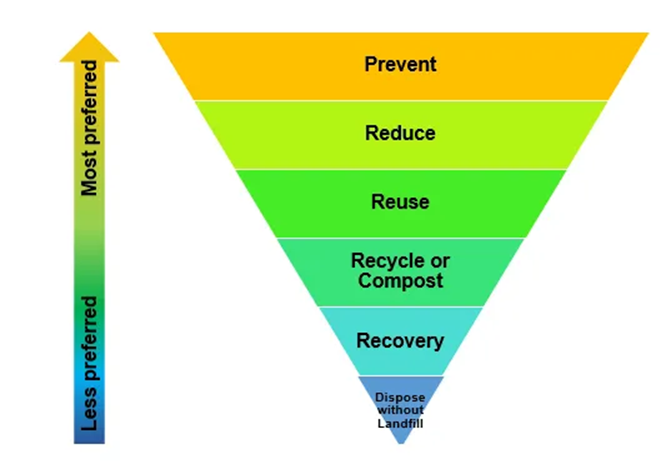
We are dedicating ourselves to spearheading innovative solutions that maximize the utilization of every ingredient, including the full utilization of fish, ensuring zero food loss. Additionally, where the local regulations allow. We are committed to adopting advanced manufacturing techniques and state-of-the-art technology to prevent waste from production and food loss in the process from ending up in landfills.
As a result, 13 of 33 manufacturing and distribution sites achieved zero waste-to-landfill status6 in 2022. We focus on waste segregation and waste utilization in order to divert the waste from disposal by increasing reuse and recycling methods.
1 SeaChange®2030, a sustainability plan to restore and protect communities and ecosystems (link here)
2 Number of lost time injuries per 200,000 worked hours. This scope is included employees and contractors in manufacturing sites, farms, hatcheries and offices (see coverage in our Sustainability Report).
3 Science Based Targets initiative
4 Five key processing facilities
5 Number of our factories in water stress using Aqueduct Country Rankings
6 Definition is according to Eurofin (link here) and Carbon Trust (link here)